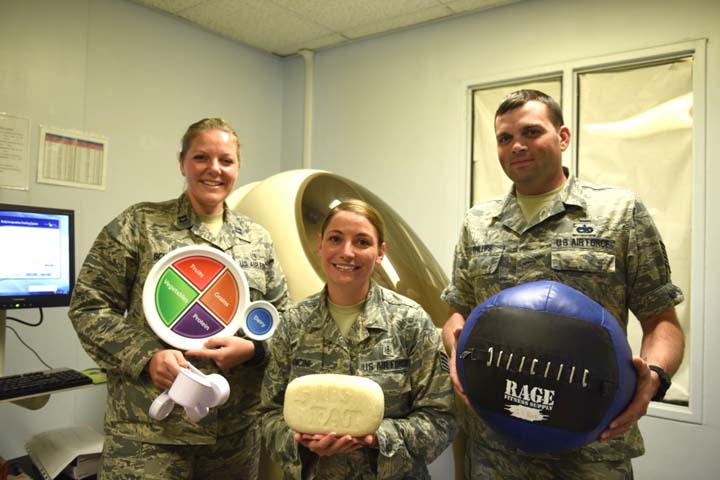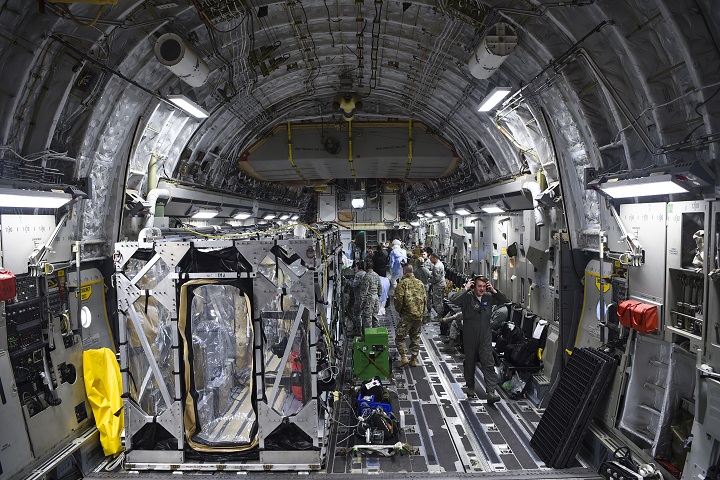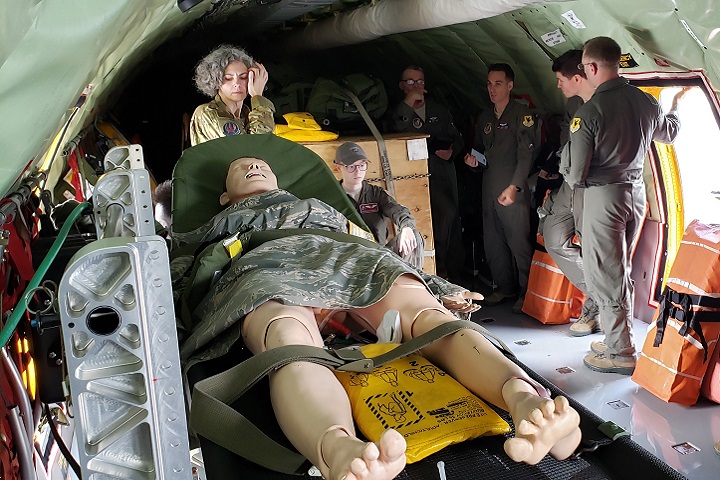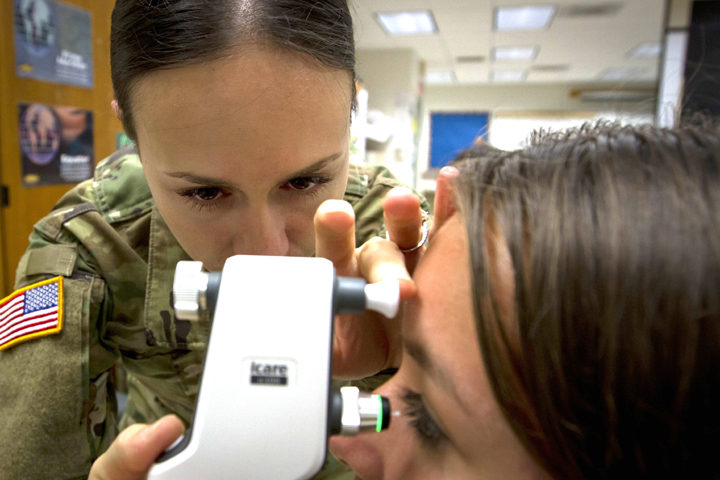
Eat well, live well

From left, Air Force Capt. Abigail Schutz, 39th Medical Operations Squadron health promotions element chief, Staff Sgt. Jennifer Mancini, 39th MDOS health promotions technician, and Tech. Sgt. Brian Phillips, 39th MDOS health promotions flight NCO in charge, pose for a photo at Incirlik Air Base, Turkey. Learning about proper nutrition can help service members stay healthy and ensure they’re in optimal warfighting shape. (U.S. Air Force photo by Staff Sgt. Matthew Wisher)
Who doesn’t have a friend or family member trying out the latest paleo, keto or other diet that eliminates processed foods including grains and sugar? Perhaps you are the one following a strict eating regimen because you want to improve your health. But have you wondered if it’s your best option?
“Many of the fad diets that we see today are just recycled old ones with new names,” explained Air Force Lt. Col. Saunya Bright, chief, health promotion nutrition, Air Force Medical Support Agency, Falls Church, Virginia. Bright described the Paleolithic or “paleo” diet as one including foods that can be hunted or gathered, such as meat, fish, chicken, eggs, vegetables, fruits and berries. The ketogenic or “keto” diet is a low-carbohydrate, high-protein and high-fat eating pattern meant to burn fat rather than carbohydrates for fuel.
While some of these diets emphasize eating more fruits and vegetables and less processed food, “some also cut out complete food groups, such as whole grains and dairy,” said Bright. She cautioned that such diets are difficult to sustain over long periods. “Eliminating food groups or types of foods increases the risk of some nutrient deficiency or disordered eating.”
Army 1st Lt. Vladi Ivanova, chief, outpatient and community nutrition at Madigan Army Medical Center, agreed. “Following a keto diet, for example, means eliminating a full food group. When we restrict certain foods, our bodies notice and may not respond in the way we want.”
Options and choices about what to eat, from diets to trendy snacks and drinks, are plentiful. The result is confusion, according to Ivanova: “My patients are asking a lot of questions, whether a diet is good or bad, or if eating certain foods will help them lose weight. They are overwhelmed by all of the information available.”
According to Bright, a return to the basics is what’s needed. “The most important suggestions for good nutrition are captured in the 2015-2020 Dietary Guidelines for Americans,” she said.
These guidelines, developed jointly by the U.S. Departments of Health and Human Services and Agriculture, provide evidence-based tools and resources that enable everyone to follow a healthy eating pattern for life.
Ivanova likes to use “MyPlate,” a tool developed by the U.S. Department of Agriculture, as a visual aid with her patients. “It shows how to fill a healthy plate of food: one-half should include fruits and vegetables, one quarter whole grains, and one quarter lean protein,” she said.
Using the guidelines, both experts agreed that a healthy eating pattern includes a variety of vegetables; whole fruits; fat-free or low-fat dairy, including milk, yogurt and cheese; and a variety of proteins, including seafood, lean meats and poultry, eggs, beans, nuts and seeds.
Bright said to avoid excess sugar, sodium, and saturated and trans fat as part of establishing a healthy eating pattern. “With all the new and trending foods, it's important to consider how substituting a certain type of food with another can impact your nutritional intake,” she said. “There are instances where foods that are advertised as ‘lower fat’ or ‘no fat’ contain increased sodium or sugar, so being aware of trade-offs is important.”
Ivanova said good nutrition is key to service members’ ability to carry out their mission as well – responding to their needs for quick, healthier meals on-the-go, and also ensuring their families are making good choices. “Often when speaking with my patients, I end up talking to them about their children’s nutrition, too. Any service member who is a parent has to model the diet that they want their kids to eat,” said Ivanova, who advocates a mindful approach to healthy eating.
“My patients have told me that after eating a fast food meal, they feel awful,” she said. “Mindfulness about how and what we eat is critical. You have to make eating healthy a priority in your life. This means taking time to understand healthy options and planning your meals in advance – perhaps for the week – so that you think through what you are putting into your body.”
Pacific Partnership 2019 participates in community health engagement in Tacloban
Article
3/21/2019

Pacific Partnership 2019 exchanges create lasting bonds of friendship and trust
Sexually Transmitted Infections
Infographic
3/20/2019

This report summarizes incidence rates of the 5 most common sexually transmitted infections (STIs) among active component service members of the U.S. Armed Forces during 2010–2018.
Testosterone Replacement Therapy
Infographic
3/20/2019

With the increasing number of testosterone deficiency diagnoses and potential health risks associated with initiation of TRT, it is important to understand the epidemiology of which U.S. service men are receiving TRT and whether these individuals have an indication for receiving treatment.
Vasectomy
Infographic
3/20/2019

There are few published studies of vasectomy and vasectomy reversal among the U.S. military population. To address these gaps, the current analysis describes the overall and annual incidence rates of vasectomy among active component service men during 2000–2017 by demographic and military characteristics and by type of surgical vas isolation procedure ...
Male Infertility
Infographic
3/20/2019

The current report updates and expands on the findings of the previous MSMR analysis of infertility among active component service men. Specifically, the current report summarizes the frequencies, rates, temporal trends, types of infertility, and demographic and military characteristics of infertility among active component service men during 2013–2017.
Airmen perform in-flight Transportation Isolation System training
Article
3/14/2019

This mission capability is the only one of its kind in the Department of Defense
Sudden cardiac death in young athletes
Article
3/7/2019

Sudden cardiac events can occur in seemingly healthy young people in their teens or twenties, including young servicemembers
Military health leaders take part in inaugural American Red Cross Advanced Life Support class
Article
3/4/2019

The transition to the American Red Cross Resuscitation Suite officially began October 1, 2018
MSMR Vol. 26 No. 3 - March 2019
Report
3/1/2019
A monthly publication of the Armed Forces Health Surveillance Branch. This issue of the peer-reviewed journal contains the following articles: Non-alcoholic fatty liver disease (NAFLD), active component, U.S. Armed Forces, 2000–2017; Cardiovascular disease-related medical evacuations, active and reserve components, U.S. Armed Forces, 1 October 2001– ...
Adenovirus
Infographic
3/1/2019

During August–September 2016, U.S. Naval Academy clinical staff noted an increase in students presenting with acute respiratory illness (ARI). An investigation was conducted to determine the extent and cause of the outbreak.
Malaria
Infographic
3/1/2019

Since 1999, the Medical Surveillance Monthly Report has published regular updates on the incidence of malaria among U.S. service members. The MSMR’s focus on malaria reflects both historical lessons learned about this mosquito-borne disease and the continuing threat that it poses to military operations and service members’ health.
Glaucoma
Infographic
3/1/2019

This report describes an analysis using the Defense Medical Surveillance System to identify all active component service members with an incident diagnosis of glaucoma during the period between 2013 and 2017.
Air Force units partner for aeromedical evacuation exercise
Article
2/27/2019

With a critical care mission spanning half the globe, practicing is vital to patient survivability
The eyes have it: Seven tips for maintaining vision
Article
2/25/2019

Most eye injuries are preventable, experts say
National Nutrition Month 2019
Infographic
2/25/2019

This infographic discusses the types of foods that make up a healthy eating plan.






















.png)











No hay comentarios:
Publicar un comentario